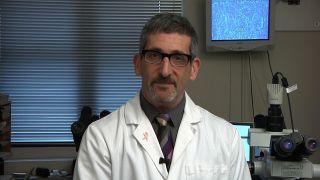Synesthesia
The Space Between
Synesthete Dr. Neil Theise discovers a "new" human organ: the interstitium.
Posted January 16, 2019
It's hardly his first rodeo.

Dr. Neil Theise is a spatial sequence synesthete, meaning he sees time as wheels around him and has an enhanced navigational sense and ability to visualize. Already widely respected for discoveries of the plasticity of adult liver cells, he has given the world another major discovery. This finding may have game-changing results for cancer treatment in the coming years.
In March, the New York University (NYU) liver pathologist and his team published about the existence of a "new" human organ, the interstitium, in Scientific Reports—an astonishing find in this advanced scientific age. The interstitium is a network of fluid-filled spaces throughout much of our bodies which has implications for the spread of cancer and fluid balance. It took two years to bring the paper to light and it was turned down by several other major journals, not because the research was doubted, but because editors thought it was not "of general interest." People couldn't see what Dr. Theise could.
Previously, it was thought that this network connective tissue in the body had no open spaces in it, but was a "a dense 'wall' of collagen—a strong structural protein found in connective tissue," explained Scientific American, reporting on the discovery, here. "But the new finding reveals that, rather than a 'wall,' this tissue is more like an 'open, fluid-filled highway,' said Dr. Theise, the co-senior study author and a professor of pathology at New York University Langone School of Medicine. "The tissue contains interconnected, fluid-filled spaces that are supported by a lattice of thick collagen 'bundles,'” Dr. Theise said, according to the magazine.
He already is looking at ways the interstitium helps cancer to spread—having demonstrated both a human melanoma and a stomach cancer tumor spreading through the interstitium to the lymph nodes in the above paper—and thinking of ways to detect this spread at earlier stages or even prevent it.
In a recent talk at the Village Zendo in Manhattan, he credited his three decades of Zen practice with the ability to see this organ. I had the pleasure of speaking with him recently about these exciting developments.
How is your research a contemplative practice...is it the focused attention?
Not every focused attention is a meditative practice. There has to be some degree of intention, either instinctive, intuitive or intended. Now, I think I would certainly be having focused attention if I did not have a Zen practice. But when I get into a physical position that is similar to the one in which I meditate, (feet on the floor, head up, eyes down) it cultivates a state of mind...
There are plenty of poets, for example, who have a highly developed attention and imagination and bring focused attention to their practice. But Walt Whitman was clearly an awakened being. Its clear in his poetry. So there was something he brought -- not only a focused attention -- but an intuition that turned it into a contemplative practice that could lead to deeper insights. Rumi is another one…
So it is focused attention, but there's also something else. And the way that affects my scientific practice, in my Zen practice, particularly in my lineage, is at the core of my work. Suzuki Roshi who founded the San Francisco Zen Center, said, "In the mind of the beginner there are many possibilities, in the mind of the expert there are few." So Zen practice is cultivating living each moment as though it is brand new, with no past, no expectation for the future, just the present, meaning in every moment you are a beginner. You're starting from scratch with no presuppositions."
Can you describe what you saw with fresh eyes that led to this discovery?
So here we had an artifact that we thought was a reflection of real anatomy. We had these dense walls of connective tissue seen for well over 100 years. Everyone accepted that these are just walls of collagen through which other structures travel, like blood vessels, nerves...Just collagen, nothing living there, just inert matrix proteins. But when you look at the slides there are cracks between some of these collagen fibers. And they look like cracks, little white spaces between the collagen. The easy explanation for this is that when you are making a slide and you are cutting tissue from stiff, formalin-fixed, paraffin-embedded tissue, which is how we make our slides, the tissue can tear a little bit. You are cutting a section four microns thin (that's four thousandths of a millimeter). So it's not surprising this stiff connective tissue might have cracks in it. That's what I was taught and that's what I've taught my trainees. Those are the pictures in all the histology books...the commentary that goes with the picture is this region is dense connective tissue through which travel these structures: dense connective tissue, dense connective tissue, dense connective tissue. It's a wall made of collagen.
And this is where people who are interested in fascia, such as osteopaths or some people who do body work like Rolfing or cranial-sacral practices, have been saying that fascia also has fluid. But allopathic trained doctors like me and conservative anatomists of the world say, 'No, when you look at it under the microscope fascia just dense connective tissue. What do you mean there's fluid there? There's no fluid there.'
So my endoscopy colleagues had this new endoscope that has a microscope at its tip that lets us look at living tissue, not fixed tissue taken out of the body to make slides. This scope looked into this dense collagen layer of the bile duct (because the duct wall is so thin that the scope could reach it) and the living tissue in this layer was not a wall of connective tissue. It looked had these fluid-filled spaces. But these spaces aren't on our slides. We eventually figured out how to close the gap between the living tissue and the dead tissue on the slides and we realized, not only in the bile duct, but in all tissues with dense collagen, the collagen wall was artifact of collapse of the spaces - the true structure is fluid, like the osteopaths and the fascia experts had been saying. But we also found lots of other layers that they had missed, the internal layers of all the visceral organs, the entire dermis of the skin, also fluid."
What are the implications of the intersitium?
It has implications for spread of cancer and for fluid balance. It has a novel cell type that hasn't been described before. It probably has implications for how immune cells travel and function. That's just starting... Since basically this finding revises the anatomy of every organ of the body, there may need to be changes, large or small, in how we think all of physiology works and how every disease progresses or could be treated. Nothing is off limits for new insights.
To me, the most interesting general implication is that what we thought was real was actually the artifact (the cracks are remnants of the real spaces). And the artifact turned out to be real (the cracks are actually fluid filled spaces flowing in and around the whole body). How cool is that? We always think we know so much, but we know so little. Every new way of looking at something will reveal things we never saw before.
I love that you credit your yoga instructor and Rolfer with aiding in the discovery. Can you explain this?
Her name is Debby Green and the healing practice that she performed on me in response to my physical difficulties has been profoundly and consistently helpful and healing. When she explained what she was doing as she worked on me, though, it made no "scientific" sense. But I've never met anyone who knows the human body as intimately as she does. So what do i do? Trust my science her trust her intuitions and experience? I lived for years with "I know you think there's fluid in there, I know you're experiencing something when you touch it, but I don't know how to explain it, 'cause I know there's no fluid there." But then when I saw that dense connective tissue has fluid in the bile duct and then other organs, I though back to: wait a second, I thought fascia was dense connective tissue - was Debby right and I was wrong? Does it have fluid?" And so in finishing our paper, which was skin and organ focused, I looked at a slide of fascia and saw it was the same. So thanks to Debby we included fascia in our paper and that led to really important interactions and now collaborations with fascia experts. It might have taken years to make those connections if not for her.
How does your spatial sequence synesthesia influence the way you're able to see what others miss? Does it affect your ability to visualize and move around space in your mind?
It’s hard for me to know if or how my spatial sequence synesthesia influences how I think of things or discover things. (He previously described it for me here: Dr. Neil Theise's Magnificent Time Wheels). I’ve never thought or experienced things with a different mind than the one I have! Before you told me that I was a spatial sequence synesthete, Maureen, I thought everyone experienced space and time the way I did. People never really talk about “how i experience space and time”. You may have said: "Wow: when you laugh I see silver stars!” to someone and they looked at you like you were nuts. But there wasn’t really ever a moment where I would have said “oh, Tuesday is located over there”.
I can imagine my spatial sequence synesthesia way of experience potentiates what I do. But I don’t really know! I’m usually just jealous of someone (you!) who can see silver stars erupt from my mouth when I laugh and would trade synesthesias with you in an instant. But maybe that would be foolish. Maybe my mash up of space and time in my awareness are what keep my work from being dull and not very creative.
Dr. Theise has also distinguished himself as a thought leader on consciousness and complexity. To see some of his fascinating talks start here. His personal website is www.neiltheise.com.




